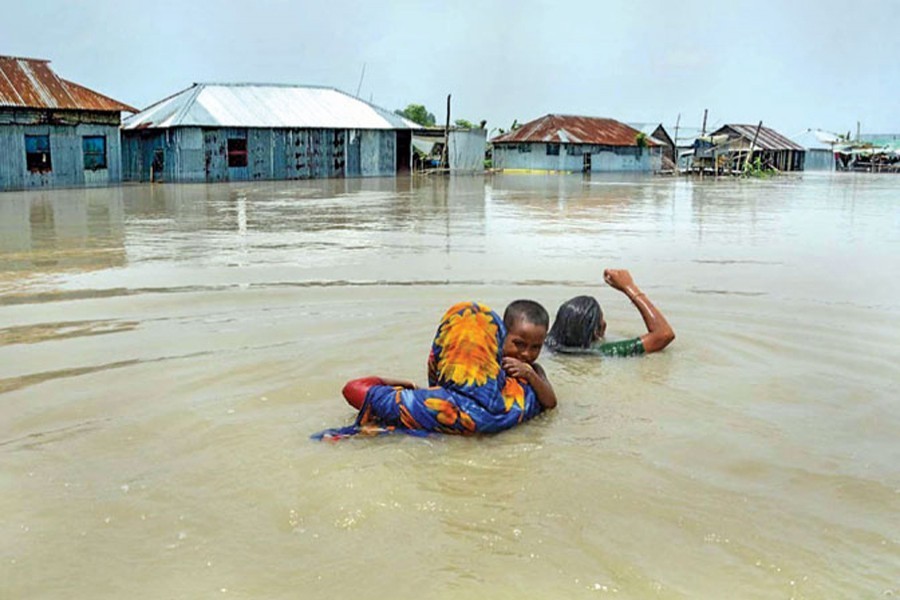Sudden-onset disasters like tropical cyclones, tidal bore, tsunami, earthquake, landslide and volcanic eruption and slow-onset events like sea-level rise, river erosion, salinity, flood, and droughts are results of environmental conditions caused by climate change.
At the end of May, cyclone Amphan swept the country. Over 2.4 million people were evacuated to temporary shelters before the cyclone hit, and over 200,000 houses were fully damaged. Coordination with local governments and health facilities is critical for communities to seek advice on how to enable access to healthcare services.
Amid the coronavirus challenges, the country is experiencing flooding of its vast areas. Flooding hit several northern districts in late June after heavy rains in Bangladesh and catchment areas of trans-boundary rivers in India. Jamalpur, Kurigram, and Gaibandha districts were the worst-affected ones, with some flash flooding also reported in Sylhet and Sunamganj districts.
Since then, flooding has been reported in several other districts. In line with a report by Network for Information, Response and Preparedness Activities on Disaster (NIRAPAD), a total of 1,012,775 people have been affected and 221,158 households marooned. The affected districts include Lalmonirhat, Kurigram, Gaibandha, Nilphamari, Rangpur, Sunamganj, Sirajganj, Bogura, Jamalpur, Sylhet, Tangail, Rajbari, and Madaripur. There was the forecast of a second wave of floods from mid-July, which were likely to submerge 23 districts. They are Kurigram, Lalmonirhat, Rangpur, Nilphamari, Gaibandha, Sylhet, Sunamganj, Netrokona, Kishoreganj, Bogra, Sirajganj, Jamalpur, Tangail, Rajbari, Madaripur, Shariatpur, Chandpur, Munshiganj, Faridpur, Manikganj, Rajshahi, Natore, and Naogaon.
The flood situation might again worsen in the two northeastern districts of Sylhet and Sunamganj after a short-term flood due to possibility of rise in water levels of all major rivers in the upper Meghna basin under the impact of onrush of upstream waters, together with heavy rainfall.
Meanwhile, the World Bank predicted that one metre rise in the sea level would inundate 20 per cent of Bangladesh's coastal region leaving 25-30 million people without home, without jobs. As per the World Bank's "South Asians Hotspot Published in September 2018". more than 134 million out of 165 million population of Bangladesh or 82 per cent people are at risk of declining living standards as a result of erratic climate change; rising temperature could affect living standards in diverse ways.
The decline in living standards as a result of changes in average weather could cost a loss of 6.7 per cent of Bangladesh's GDP (gross domestic product) by 2050 unless actions are taken to reduce emissions and global annual average temperature increase. If the current trend is not reversed, nearly 800 million people of South Asia will be affected and if corrective actions are taken, still around 370 million would be affected.
In 2017 when flash flood inundated the haor (marshy) areas, 75 per cent of crops was inundated resulting in loss of 2.2 million tonmes of rice, 1.1 million families were affected, 2,000 tonnes of fish and 30,000 ducks were killed. The loss was estimated at Tk 130 billion.
According to Climate Risk Index of German Watch during 2000-2011, nearly 70 million Bangladesh people were affected by erratic climate disaster costing Tk 500 billion. This means due to climate disasters, Bangladesh loses Tk 40 billion a year. Owing to climate disasters, the nation's GDP is negatively affected by 1.8 per cent on average.
In view of Bangladesh's climate vulnerability, Prime Minister Sheikh Hasina has taken actions to cope with natural disasters. She adopted "Climate Change Strategies and Action Plan" as early as in 2009. Communities have been involved with creation of 6,000 well-trained volunteers and nearly 3,800 cyclone shelters were erected.
The country has built embankments in nearly 70-80 per cent of coastal areas and arranged irrigation facilities in 80 per cent of its cultivable areas. The current situation demands development of flood-resistant saline-resilient crops, supporting flood-affected people, promoting Covid-19 healthcare services, supply of pure water, and proper sanitation to ensure social welfare during the pandemic and adapt with the climate change effects.
Shishir Reza is an environmental analyst and Associate Member of Bangladesh Economic Association.


